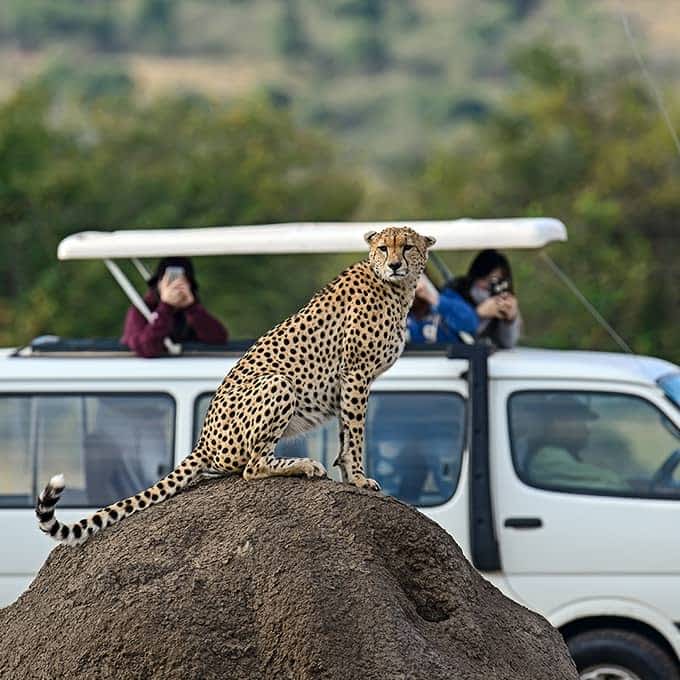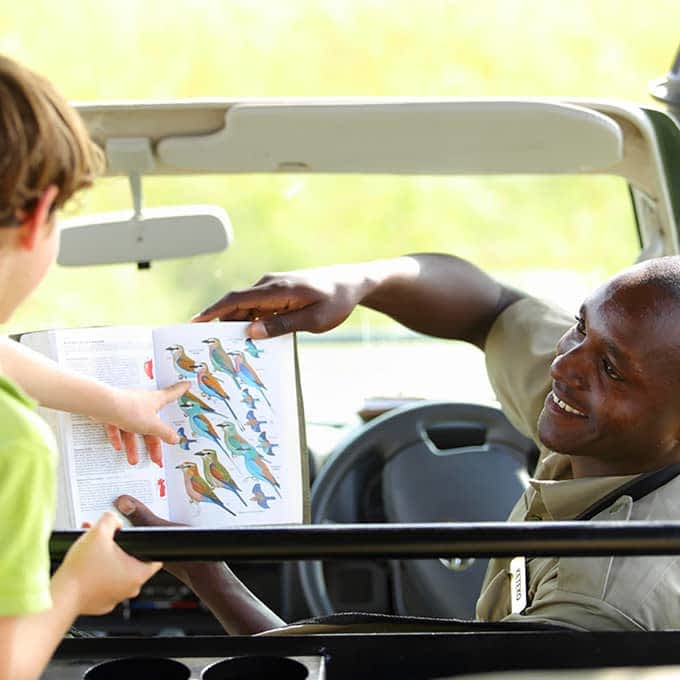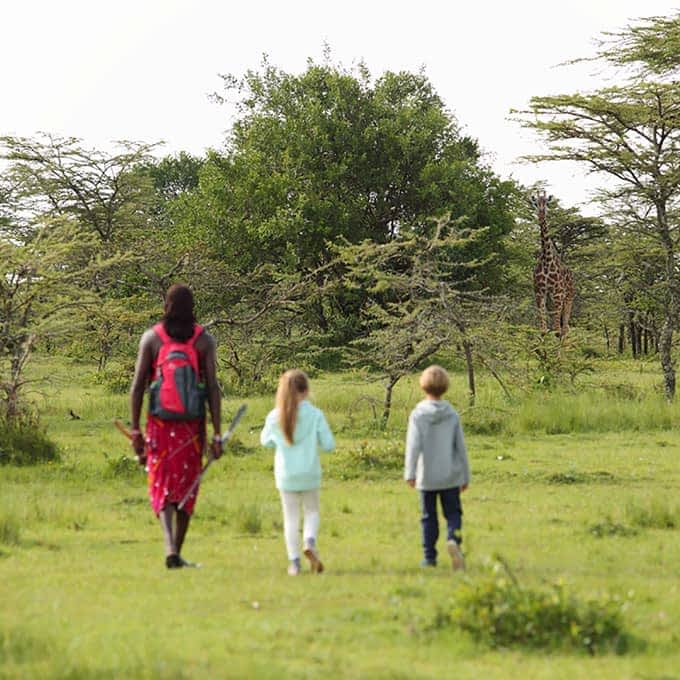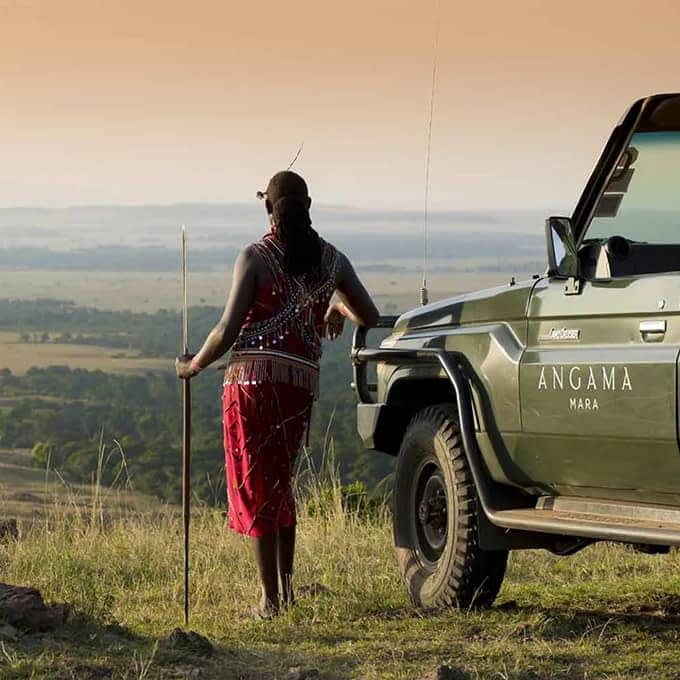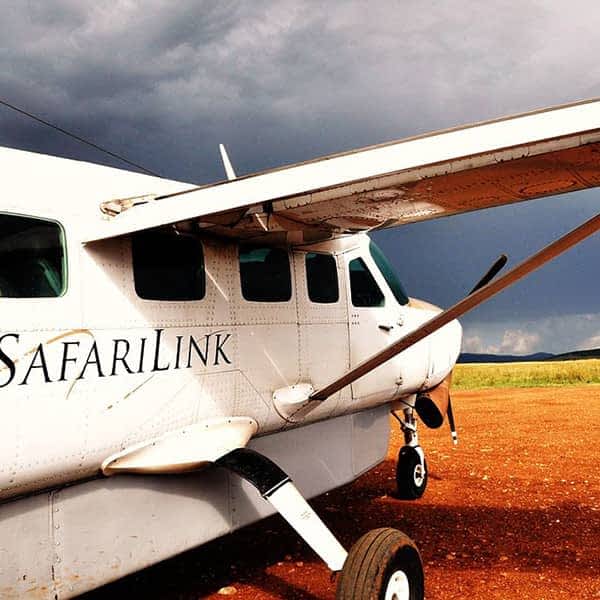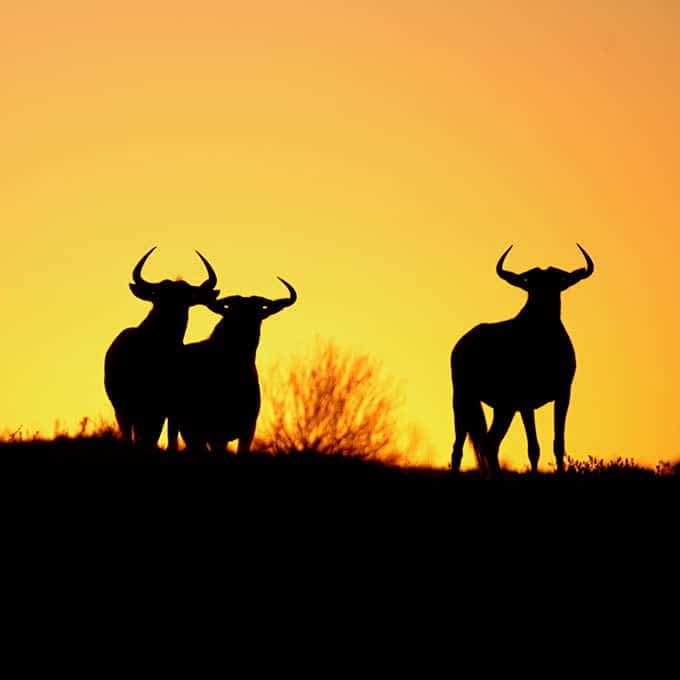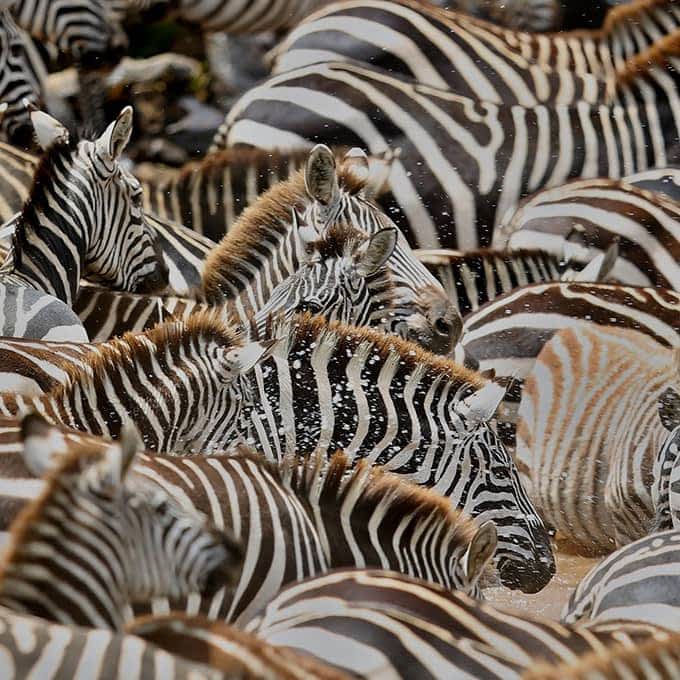A typical day in the Masai Mara
Obviously when in Rome, you do as the Romans do... so when on safari in the Masai Mara, do as the local wildlife does. Most animals are early risers and like to set out for a meal long before the crack of dawn. Accordingly, most safari lodges offer early morning game drives giving you the best opportunity to catch a glimpse of as many animals as possible. Breakfast is either served before the drive, packed for along the way or can be enjoyed upon returning to the property. After a morning safari (which typically lasts two to three hours) you’ll have some downtime and can freshen up for lunch. After an afternoon nap, some light reading or spotting wildlife in the surroundings you may head back out for an evening game drive at dusk. Naturally it is not all work and no play, to add to your safari experience your lodge may surprise you with a chilled bottle of an excellent fine wine to sip during your sundowner. After an exciting day of safari in the Masai Mara a lovely dinner by campfire awaits. The perfect ending to the perfect day.
Masai Mara safari activities
Naturally the description above is just an example of what you can expect during your Masai Mara safari. Each safari lodge or tented camp in the Masai Mara offers its own program of safari activities. In addition to game drives you may have an opportunity to go on a guided nature walk, to take to the clear blue skies for a hot air balloon safari, to go for a bush picnic, to visit a local Masai manyatta (village) or to take part in other optional activities. Keep in mind that some of these activities may not be included in the price of your safari and may require an additional fee (such as hot air balloon safaris). In any case, there’s plenty to keep you entertained during a safari in the Masai Mara. No need to worry about being bored during your trip.
Getting to the Masai Mara
There are two ways to travel to the Masai Mara after arriving in Kenya. If you’re looking for a fast and convenient way to travel, or just have a few days to spend in the area, your best option is to fly to the Masai Mara. Flying is a quick and comfortable mode of travel and is made easy through daily flight options to the various airstrips in and around the Masai Mara. The airstrip you fly into depends on which accommodation you plan to stay at. Flying time from Nairobi to the Masai Mara is approximately 40 – 45 minutes.
On the other hand, driving from Nairobi to the Masai Mara can definitely add to the feeling of freedom and adventure. If you would like to do some sightseeing en route from Nairobi to Masai Mara or would like to save a dime on transportation, taking to the open road is the way to go. The downside to this is that the roads are notoriously rough and unreliable and the drive will take approximately six to seven hours. However, if it is an adventure you crave, driving to the Masai Mara from Nairobi will certainly be your cup of tea. That being said... most people choose to fly to the Masai Mara.
Learn all about getting to the Masai Mara.
Flying to the Masai Mara
If you choose to fly into the Masai Mara, there are two airlines that can take you to one of local airstrips: AirKenya and Safarilink. Each safari lodge or tented camp has its own preferred airstrip, so your choice of accommodation determines which airstrip you will fly into. Upon your arrival at the airstrip, one of the lodge's guides or trackers will be waiting to take you to your accommodation. Flights depart from Nairobi’s Wilson Airport (WIL) to the Masai Mara airstrips once (or more times) a day. Guests at Governor’s Camp can enjoy air travel via the camp's own private airline, Governor’s Aviation. The airline flies guests from Nairobi’s Wilson Airport to the Musiara airstrip, which lies only two kilometers or a ten-minute drive from Governor's Camp. Read all about flights to Masai Mara.
Masai Mara by road
Those with an adventurous heart, a sturdy high clearance 4WD and some time to kill can brave the road from Nairobi to the Masai Mara. Although hard-surfaced paved roads out of Nairobi have improved in recent years, the last leg of the road trip could prove quite bumpy and off-road-ish. The roads just outside of the Masai Mara National Reserve (or in fact everything past Narok), all roads within the reserve and the roads leading up to the conservancies are all either made up of gravel, dirt or mud. It goes without saying that planning is everything if you do decide to travel by road. Make sure you have exact directions and know where your accommodation is located. Also try to top up on fuel if you pass by Narok, or if your road trip takes you on a different route, at Talek Village. Since you'll be traveling in unknown territory with few petrol stations, we recommend having an extra jerrycan of spare fuel in your vehicle.
Safari drives in Masai Mara National Reserve & conservancies
Once you reach the Masai Mara, a cornucopia of wildlife awaits. If you decide to stay at a lodge in one of the conservancies, your lodge will offer a variety of safari options. One of those could be day safari into the Masai Mara National Reserve proper. Please keep in mind that if you plan on staying at a lodge within the actual National Reserve, it will not be possible to do a day trip into a neighboring conservancy. Safaris within the conservancies are only possible for those staying at lodges within their boundaries.
Bush meals, sundowners and campfire dinners
Good food is the spice of life. Your culinary experiences during a safari in the Masai Mara will undoubtedly add to the unique and exotic safari atmosphere. Each of the safari lodges and camps featured on our site offers its own lovely selection of palate-pleasing cuisine prepared with local and seasonal ingredients. Whether you like to start your day in silence with a steaming cup of coffee while staring out across the champagne coloured African plains or prefer sitting down to a bountiful breakfast buffet in the company of fellow guests, each lodge offers something for everyone.
While you’re out and about, most accommodations offer a packed lunch filled with tasty surprises to compliment your safari in the wild. As the sun begins to set, it’s the perfect time for a sundowner (simply put, the Masai Mara’s happy hour). While you sip on your favorite drink or cocktail, and nibble on some tasty snacks, you can dreamily watch the sun disappear beneath the horizon in a gorgeous display of fiery golds and reds. At the end of the day, a fireside dinner awaits. The glow of lantern-lit trees and the star-studded sky above only add to the ambiance and make these dinners something to look back upon with a smile for a very long time to come.
Special meal arrangements
Safari lodge staff in the Masai Mara generally go out of their way to make your stay pleasant and memorable. So, if by chance you have special dietary requirements, simply make sure you inform the lodge of this. Their chefs will ensure that they provide you with meals that take your diet into account.
What to pack for your Masai Mara safari?
Much like when travelling to any other destination, when packing for the Masai Mara – less is more. If you're flying into the Masai Mara, keep in mind that you’re only allowed up to twenty kilograms of luggage (preferably softshell travel bags) on domestic charter flights. Base your packing on the length of your stay and your destination, but here are few pointers.
Safari must-haves and leave-at-home’s
- Leave your brightly coloured statement items at home and choose instead to pack clothes in muted, understated colours that blend in with safari surroundings.
- Pack light fabrics and loose-fitting, quick-drying clothing. Most camps and lodges offer laundry service, so no need to pack much.
- Pack a warm sweater (or jacket) and a scarf. Mornings and evenings can get rather chilly, you won’t want to set off on a game drive without something to keep you warm. If your favourite sweater doesn’t do the trick, most camps provide ‘bush babies’ (we’ll keep you in suspense for now…) and blankets.
- We understand you may want to wear shorts during a safari drive or bush walk, but as a sign of respect you may want to opt for trousers when visiting manyattas (rural villages).
- No need to glam up for your stay at the lodge, casual dress is the norm at safari camps and lodges.
- A flexible hat and a pair of sunglasses with UV protection are a must-have during your trip.
- It may seem like a good idea, but please leave your camo-wear at home. Wearing camouflage or military-themed clothes is considered inappropriate in the Masai Mara and could lead to you being questioned by the local authorities.
- Since you'll be navigating uneven terrain during game walks (and may also encounter some creepy crawlies along the way), we recommend wearing closed-off, lightweight, sturdy footwear with ankle support. It is best if they’ve been worn-in a little and given a test run during a few long walks at home. There’s nothing like ‘new shoe blisters’ to make you feel miserable during a walking safari.
- Curiously enough, it's better to pack a few pairs of thin socks than one pair of thick socks. Wearing several layers of thin socks is actually more comfortable. Visit an outdoor specialty store for more information on the best socks to bring along. They're more important than you would imagine.
The essentials
Although you could probably borrow any essentials that you forgot to pack from your lodge, it’s good to come prepared. Here are a few trusted and true items we like to pack when going on safari.
- Binoculars are a safari travelers’ best friend for spotting the one that almost got away or for scanning the plains.
- Obviously, you would not want to leave home without your camera.
- Leave expensive watches and jewelry where they belong, back at home. However, do pack a cheap waterproof watch.
- High UV protection sunblock and lip balm. Trust me, you may want to pack a second tube of lip balm, just in case. For some reason they always seem to go missing.
- High-quality insect repellent. Your best friend against mosquitos and malaria.
- BYOB – bring your own bottle for water. Your lodge will have these as well, but to limit the use of plastic bottles and make your stay eco-friendlier, bring your own.
Taking picture-perfect safari snapshots
There are few things more rewarding than getting the perfect picture at just the right moment. A lioness sprinting after her prey, a family of warthogs crossing in front of your safari jeep, a giraffe nibbling on some fresh green leaves; these are the pictures you’ll want to be able to look through in the years following your trip. Here are a few tips for taking the best possible pictures during your safari in the Masai Mara.
We recommend using a (digital) SLR camera with one or more lenses. When taking pictures of wild animals, a lens with a minimum range of 200 mm is essential, although a 300 mm lens would be even better. When it comes to landscape photography, a wide-angle lens (18 mm or less) is recommended. Use lenses with a fixed focal length (usually a 50 mm lens provides good results) and large aperture for portrait shots. Don’t want to carry heavy camera bags while on safari in Masai Mara? A 18-200 mm zoom lens will work nicely and you should be able to get most objects in range. Take care to protect your equipment during your safari in Masai Mara. Driving on dusty, unpaved roads means having to keep your camera covered up in a bag at all times to prevent damage.
Staying safe while on safari in Masai Mara
Going on a safari in the Masai Mara is an exciting adventure. Keep in mind though, that there are certain rules in place to guarantee your safety during your stay in the Masai Mara. Here are a few things to keep in mind in order to enjoy your safari safely.
- While out on safari in the Masai Mara National Reserve or in the conservancies, it is absolutely prohibited to step out of a safari vehicle if you are not being accompanied by an armed ranger and/ or guide. Unfortunately there are countless tragic examples of visitors who did not follow this rule and paid very high prices for ignoring it.
- If you decide to fly to the Masai Mara, someone from your lodge will come to collect you from the airstrip upon your arrival. Once you reach the lodge your ranger or the accommodation staff will brief you on the safety precautions for visitors at the lodge. Please pay attention to this briefing. The lodge's staff has inside knowledge on the presence of animals in the area at the time of your visit.
- Lodges and camps in the Masai Mara are unfenced. Wildlife can freely enter the premises, which they regularly do. This adds an extra element of adventure and excitement to your trip, but also requires precautions. Please do not walk around the lodge unaccompanied after sunset. If you wish to visit the main building, restaurant or bar after dark, just dial the reception area and they will send someone to accompany you across the grounds.
If you have unanswered questions after reading the above, please let us know. We look forward to answering any questions you may have about going on safari in Masai Mara. You may also be interested in reviewing our FAQ page.
Further reading

